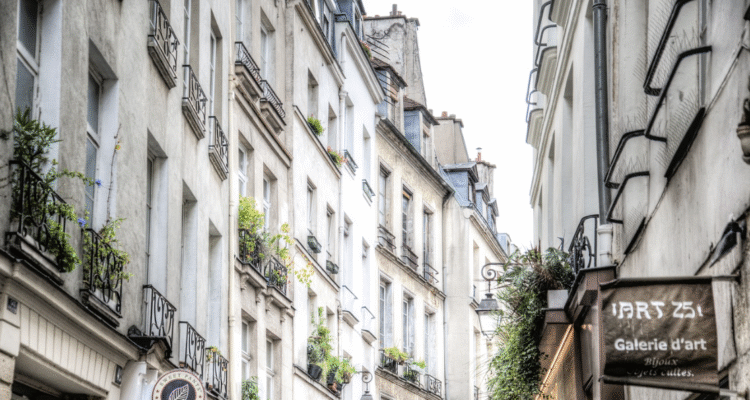Where aristocrats, rebels, and falafel all share the same cobblestones.
The Marais may now be Paris’s most polished paradox—artsy but posh, ancient yet Instagrammable—but beneath its cobbled charm lies a layered, rebellious, shape-shifting past. Straddling the 3rd and 4th arrondissements, this district has been everything from a swamp (its name literally means “marsh”) to a medieval stronghold, aristocratic playground, Jewish heartland, revolutionary crossroads, and LGBTQ+ sanctuary.
The Socialites took a walk through time to unearth the lesser-known stories that still echo through the hôtels particuliers, synagogues, hidden gardens, and falafel lines.
🏰 The Marais Was Once an Aristocratic Vanity Project
Before it was bohemian, it was blindingly elite. In the 17th century, the Marais became the place to build a hôtel particulier—private mansions with lavish courtyards, salons, and secret gardens.
-
The Place des Vosges, built in 1605, was Paris’s first planned square—symmetrical, royal, and revolutionary in urban planning.
-
Madame de Sévigné, known for her glittering letters, lived at 7 Rue de Sévigné—her witty dispatches captured the tone of the pre-Revolution elite.
📍 Still standing: Hôtel de Sully (62 Rue Saint-Antoine) and Hôtel Carnavalet, now the Museum of Paris History, are windows into this aristocratic golden age.
✡️ The Marais Is the Historic Heart of Jewish Paris
By the 13th century, Jews had already settled in what became the Marais, but after cycles of expulsion, the area saw a revival in the early 20th century, especially around Rue des Rosiers.
-
The neighborhood became known as “Pletzl” (little place, in Yiddish), with kosher bakeries, synagogues, and Jewish schools.
-
During WWII, the Marais was heavily affected by the Vél’ d’Hiv roundup—many plaques around the 4e bear silent witness.
📍 Don’t miss: The Shoah Memorial (17 Rue Geoffroy-l’Asnier) and the Agoudas Hakehilos Synagogue by Hector Guimard (10 Rue Pavée)—an Art Nouveau gem.
👗 It Was Once the Capital of Paris Fashion
Long before the Marais was full of edgy galleries and upmarket boutiques, it was the textile and garment district of Paris.
-
The neighborhood was filled with tailors, workshops, fabric merchants, and leather goods artisans.
-
Today’s rue du Temple and rue des Francs-Bourgeois still carry the echoes of that industrious creativity.
📍 Fashion whisper: Look closely at building signs—some still list the trades once carried out inside.
🪧 The Name “Francs-Bourgeois” Isn’t What You Think
Rue des Francs-Bourgeois isn’t named for the current well-dressed locals. It actually refers to “bourgeois who were exempt from taxes”, likely thanks to some religious or civic privileges during the Middle Ages.
🕯️ Also curious: Many streets here bear names linked to long-gone convents, trades, or pious acts. Rue du Roi de Sicile? It was once home to crusaders. Rue des Blancs-Manteaux? Named after a mendicant order.
🧑🎨 The Marais Was Revived by Artists (and André Malraux)
By the mid-20th century, the Marais had become neglected, even derelict. Its grand buildings were falling apart—until culture stepped in.
-
In 1962, André Malraux, de Gaulle’s Minister of Culture, declared the Marais a protected historic district—the first of its kind.
-
This move attracted artists, intellectuals, and eventually the queer community, who made the crumbling mansions cool again.
📍 Artistic legacy: The Musée Picasso (in the Hôtel Salé) and Maison Européenne de la Photographie are part of this post-revival wave.
🏳️🌈 It Became the Heart of Gay Paris
In the 1980s and 90s, the Marais bloomed into Paris’s LGBTQ+ stronghold, with bars, bookstores, clubs, and cafés opening around Rue Sainte-Croix de la Bretonnerie and Rue des Archives.
-
Le Cox, RAIDD, and Open Café became institutions of community, activism, and celebration.
-
Despite gentrification, the Marais remains a vital queer cultural zone, particularly for Pride and Nuit Blanche festivities.
📍 Still iconic: Les Mots à la Bouche, Paris’s queer bookstore, now on Rue Saint-Ambroise but originally in the Marais for over 40 years.
📚 Victor Hugo’s Home at Place des Vosges Was Almost Torn Down
Yes, that Victor Hugo. He lived at No. 6 Place des Vosges, and it was here that he began writing Les Misérables. In the early 1900s, the house was nearly lost to renovation plans—until activists stepped in and converted it into a museum.
📍 Maison de Victor Hugo is still one of Paris’s most atmospheric small museums—and has views onto the square that feel like a whisper from the past.
Final Word from The Socialites:
The Marais isn’t just beautiful—it’s layered, full of cultural tension and transformation. From medieval tax loopholes to the salons of aristocrats, from deportation memorials to rainbow flags, its stones have absorbed every version of Paris.
So next time you’re there, look beyond the facades. The stories are still breathing.
—The Socialites


